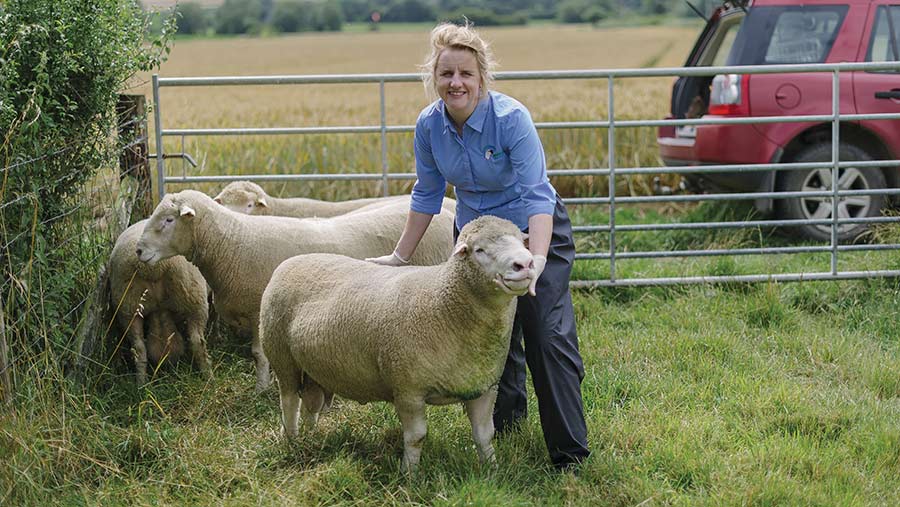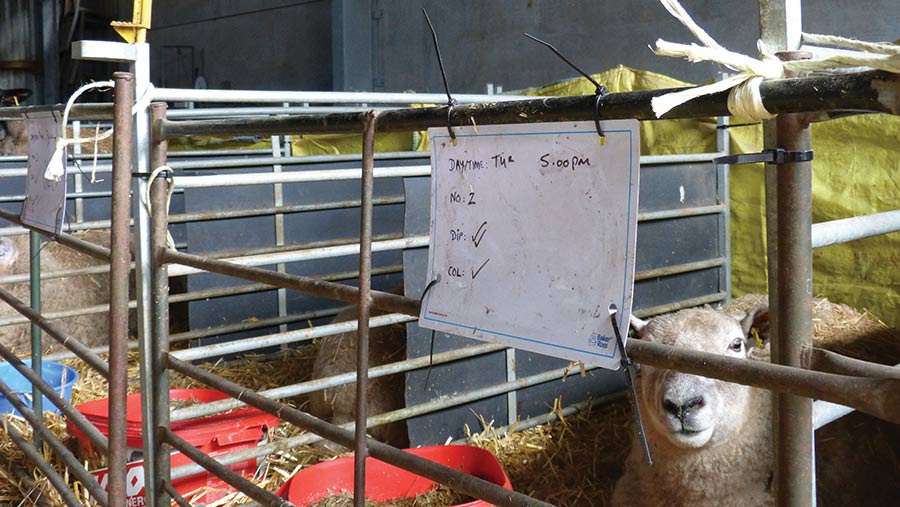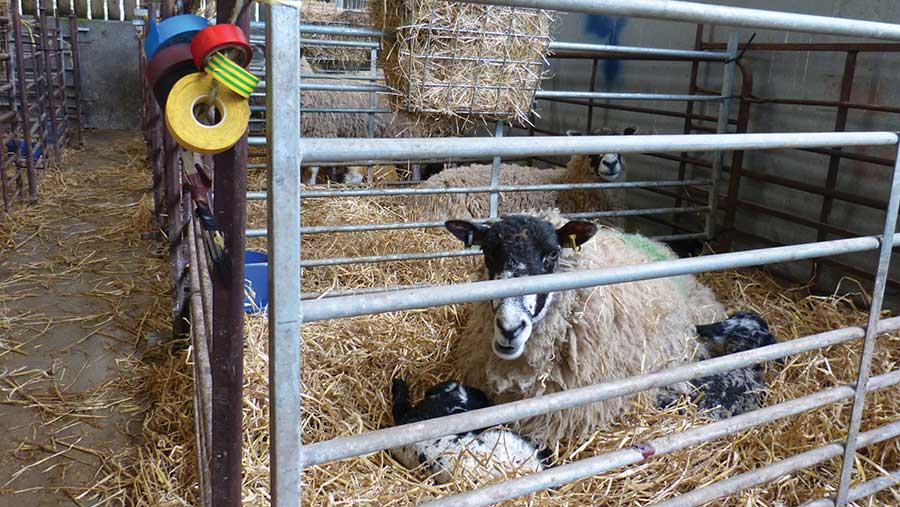Lambing shed communication – why and how to improve it
 Sheep vet Emily Gascoigne © Jim Wileman
Sheep vet Emily Gascoigne © Jim Wileman Keeping lines of communication open to track vital lambing shed jobs can help higher-output flocks keep standards high.
Sheep vet Emily Gascoigne of Synergy Farm Health believes verbal and non-verbal communication such as simple tape or card systems can increase output and cut lambing shed mortality – even in good sheep businesses.
She believes a lambing shed should be a relaxed and orderly place, like a well-run hospital maternity ward, which is helped by efficient communication systems.
See also: How Anglesey farmers have cut antibiotics at lambing by 60%
Emily gives some pointers she has seen work well on farms.
1. Give time for a handover talk
- A handover period between shifts is very important for lamb survival (see “The six-hour window”). This is so a lamb that has just been born at the end of one shift can be checked, and fed if necessary, at the start of the next shift
- Any lambs requiring additional care (extra colostrum, checks) should be noted
- Pay staff to arrive 10-15 minutes before their shift to tour the pens
- During this time, identify priority sheep for fostering and which lambs need colostrum (see “Colostrum targets”)
The six-hour window
- Achieving the three Qs of colostrum (quantity, quality, quickly) needs to happen within the first six hours of a lamb’s life
- The lamb’s ability to absorb immunoglobulins from the colostrum into its bloodstream reduces considerably after six hours
Colostrum targets
- First two hours: 200ml of colostrum
- First 24 hours: 200ml/kg of birthweight in colostrum, so a 5kg lamb requires 1 litre and a 3.5kg lamb requires 700ml
- Main antibody in colostrum is immunoglobulin G (IgG)
- IgG concentration in ewe milk decreases rapidly after birth, by about 3.3mg/ml an hour, and to zero by 23 hours after lambing
- Colostrum should be 26.5% IgG for lambs on the Brix scale. Alternative sources are (in order of preference): colostrum from another ewe on the farm, pooled cow colostrum, and artificial colostrum powder
2. Use pen charts or colour coding for essential protocols
- Signage showing whether key jobs have been done or still need doing can save time and reward you with lower mortality and a higher percentage of lambs sold come summer
- Use fibreboard to make a 20x20cm board for each lambing pen. Paint the board in blackboard paint (£5/tin) and give each member of staff their own colour chalk to write on boards
- On each board, chalk the day and time of birth, a score out of three for ease of lambing, and the number of lambs in the pen (to check for smothering). Leave space to write “S” (for supplement), denoting that the lambs need extra colostrum
- Ensure recording is quick and easy, then it gets done
- Pen cards might not suit some people. Another option is a system of strings or electrician’s tape, using different colours for triplets, fostering, lambs that needed assistance or that need extra colostrum, and so on
3. Address problem animals
- Make clear any lambing shed culling offences are known by all staff to reduce problems the following year
- Keep some blank ear tags or an ear notcher in everyone’s lambing box to mark problem ewes
- Mastitis, lambing difficulties, vaginal prolapse and any other culling offences can all be recorded. There is great capacity with electronic identification software systems to track these offences in individual sheep
4 Maintain supplies and keep staff updated
- A WhatsApp group or whiteboard can ensure important messages reach all staff
- Similarly, staff can use these methods of communication to ask questions and request refills of syringes, plastic gloves, disinfectant and so on.
- Remember, a fresh pair of gloves should be worn to lamb individual ewes because the bacteria (particularly Streptococcus dysgalactiae) that cause joint ill live around the vulva. Changing gloves between each ewe manages this risk
- Disinfectant supplies and hot water (kettle/urn or plumbed) are essential for keeping milk bottles hygienic. If a bottle is not in use, keep it in a Milton sterilising bath or in a solution of hot water and soap

An example of a pen card system showing date of birth and iodine and colostrum jobs © MAG/Michael Priestley
5. Make time for hygiene
- It is not always possible to give pens rest time between sheep, but a good rule of thumb is having a 1:10 ratio of pens to sheep. For example, a 300-ewe flock needs about 30 pens made up, depending on lambing speed and use of teasers
- Best practice is to clean out the pen to the floor, leave the ground bare for a long as possible with a desiccant product on it. This dry period helps to manage pathogens.
Graeme Wood, AWSM Farming, County Durham
A team of six will manage the lambing of 1,560 mostly Cheviot cross Texel ewes this spring at AWSM Farming near Barnard Castle, County Durham.
This year, lambing will start on 17 February, with 70 ewes expected to lamb by 1 March and up to 350 a week thereafter until April.
Shepherd Graeme Wood, who has been managing the sheep enterprise for nearly 16 years, explains lambing shed communication:
- Yellow baler twine Light milk production in one side of the udder, meaning extra attention will be needed and her lambs will likely need topping up with milk
- Red baler twine Twins needing attention. If a ewe looks short of milk, red string will alert staff to keep feeding the lambs
- Morning meeting Graeme will have a quick handover talk with the night lamber, ensuring any sheep needing attention remain a focal point that day
- Blackboard Key messages on where sheep are coming from and heading to (usually in batches of 50) are communicated on a blackboard near the break room
- Mothering mark A ewe that has a lamb fostered onto her has an “M” sprayed on her side to help with monitoring in loose housing and at pasture.
Martin Tobutt, Biddesden Farms, Wiltshire

© MAG/Michael Priestley
Head shepherd Martin Tobutt leads a team of four, lambing 1,000 North of England Mules indoors in five weeks, and he has seen the benefit of using a tape system.
Previously, whiteboards were used, but these would often not be wiped clean. He has found the staff like the tape system. Tape is wrapped around the top rail of the pen and removed each time the ewe leaves to the pasture or loose yard.
Nine differently coloured electrician’s tapes are used to direct staff, as follows:
- Blue Single
- Silver Twin
- Green and yellow Triplet
- Orange Watch closely (weak lamb)
- Red and white Foster shed
- Yellow Fostered on
- White Fostered off
- Brown Dead lamb
- Black Lambing assisted.
